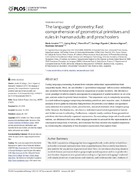Please use this identifier to cite or link to this item:
https://repositorio.ufrn.br/handle/123456789/22104| Title: | The language of geometry: Fast comprehension of geometrical primitives and rules in human adults and preschoolers |
| Authors: | Amalric, Marie Wang, Liping Pica, Pierre Figueira, Santiago Sigman, Mariano |
| Keywords: | geometrical language;spatial locations;geometrical lexico |
| Issue Date: | 26-Jan-2017 |
| Portuguese Abstract: | During language processing, humans form complex embedded representations from sequential inputs. Here, we ask whether a “geometrical language” with recursive embedding also underlies the human ability to encode sequences of spatial locations. We introduce a novel paradigm in which subjects are exposed to a sequence of spatial locations on an octagon, and are asked to predict future locations. The sequences vary in complexity according to a well-defined language comprising elementary primitives and recursive rules. A detailed analysis of error patterns indicates that primitives of symmetry and rotation are spontaneously detected and used by adults, preschoolers, and adult members of an indigene group in the Amazon, the Munduruku, who have a restricted numerical and geometrical lexicon and limited access to schooling. Furthermore, subjects readily combine these geometrical primitives into hierarchically organized expressions. By evaluating a large set of such combinations, we obtained a first view of the language needed to account for the representation of visuospatial sequences in humans, and conclude that they encode visuospatial sequences by minimizing the complexity of the structured expressions that capture them. |
| URI: | https://repositorio.ufrn.br/jspui/handle/123456789/22104 |
| Appears in Collections: | ICe - Artigos publicados em periódicos |
Files in This Item:
| File | Description | Size | Format | |
|---|---|---|---|---|
| PierrePica_ICE_2017_The language.pdf | 2,81 MB | Adobe PDF |  View/Open |
Items in DSpace are protected by copyright, with all rights reserved, unless otherwise indicated.

